The Oregon offense continues to evolve and progress since my instructional video series was created four years ago. Those videos have been viewed more than a million times in total! They have been helpful to fans, as well as to coaches looking to install the spread offense (Oregon style).
However, defenses have become better at defending the spread, and thus the Oregon coaching staff has adjusted their base plays to stay ahead of the curve.
The first major change occurred with the new Inside Zone Read I wrote about last year, and now the Power Play has been altered to stay in tandem with the new Inside Zone Read. To brush up on the basics of the play that you will see often in the Oregon offense, please view the video below. It provides a foundation for today’s summary of the New Power Play in the Oregon offense.
(Please overlook the terrible lighting and sound in the video, as it was our early days when we shot this with a family video camera, and we did not have an understanding of lighting yet. Note my hesitation trying to remember my lines, as this was also before we got a teleprompter. Oh, the memories!)
The Power Play (above) has been around for more than one hundred years and is a classic smash-mouth kind of play. Chip Kelly adapted it to the Oregon spread offense, and now Oregon head coach Mark Helfrich has refined it further to match up with the Ducks’ Inside Zone Read play.

The Oregon Power Play is pretty simple; the running back (green dotted line/arrow above) runs the same path as an Inside Zone Read, as the quarterback takes a step back to give the RB a straight path. The pulling guard No. 78 Cameron Hunt, (red line/arrow above) is targeting the linebacker between in the B-gap (between the guard and tackle) on the opposite side of the formation.
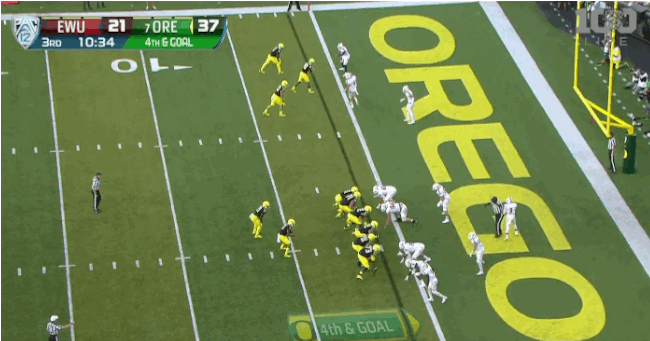
This is the “Bang” running path of the Power Play.
This “bang” or as some coaches call it, “blast,” running path for No. 21 Royce Freeman, (above) is very straightforward: follow the pulling guard into the gap and blast for yardage. Another great example of this running path is in the article about Oregon’s new Inside Zone Read as Thomas Tyner takes it right up the middle for a touchdown over a longer distance!
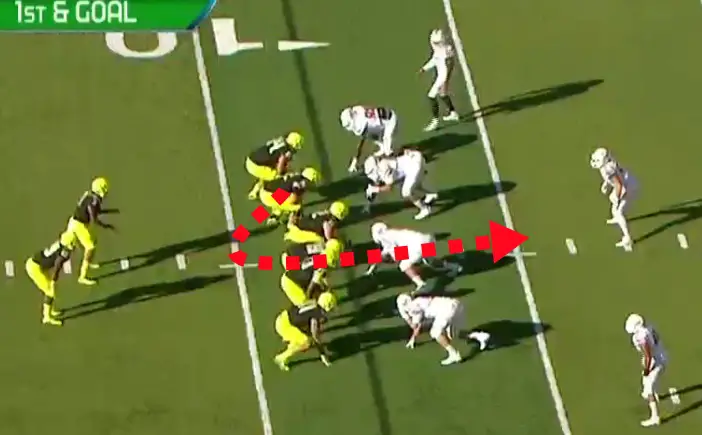
Pulling the guard to the other side!
The Power Play can be run in three variations by the running back, who adjusts to the blocking in front of him. Above we see the Power Play going to the other side, as the left guard, No. 62 Matt Pierson (dotted run line/arrow above), is pulling to the guard/tackle B-gap on the right side.
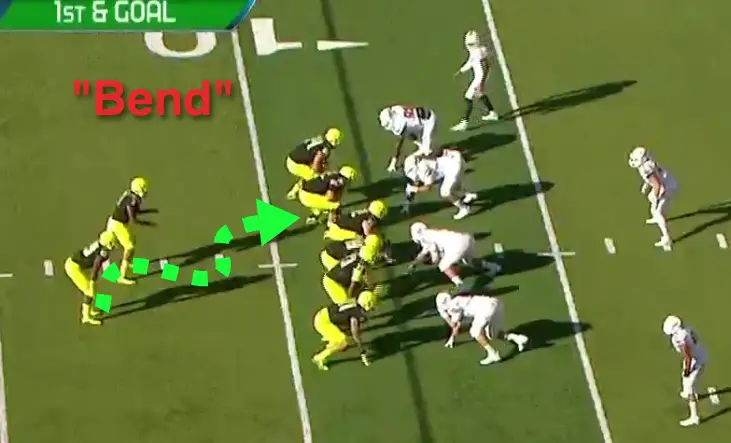
A running back with good vision and superb reflexes can ”bend” his running path based on the blocking or the overreaction of the linebackers to the initial action. Even though the play was created to go to the right side of the line of scrimmage — Kani Benoit bends it back to the other side. This example is not as extreme again as the example in the Inside Zone Read article with Tyner, but you get the idea.
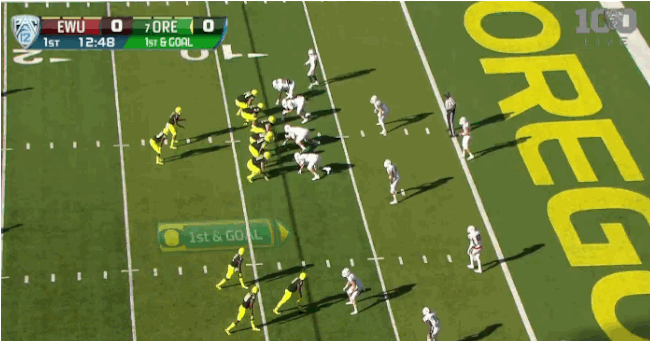
Great eyes by the running back …
Success with this play (above) is dependent not just on the blocking, but the skill and vision of the running back.
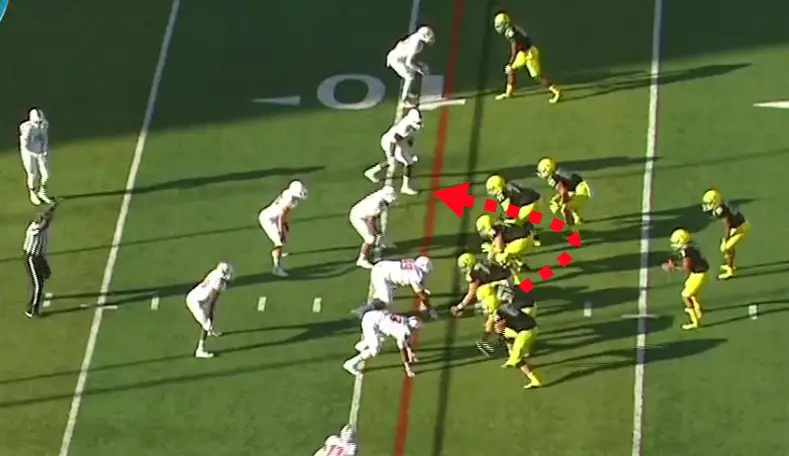
Doug Brenner is going to hurt someone …
The third variation of the Power Play begins the same as before, only this time it is No. 57, Doug Brenner, pulling to lead up on the B-gap linebacker (above).
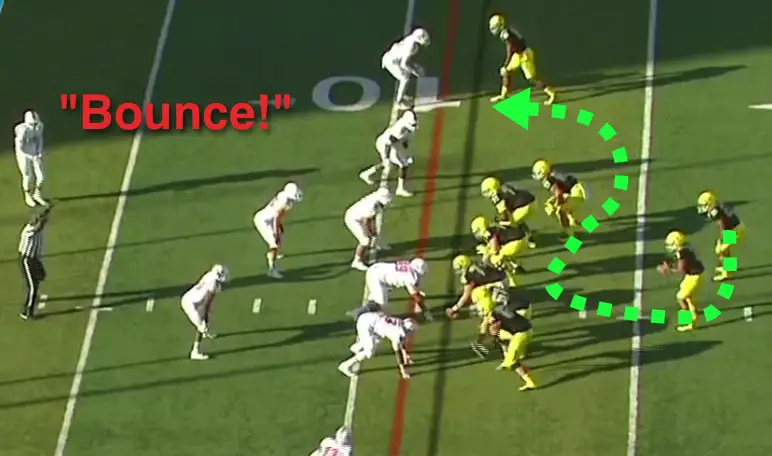
Tony Brooks-James makes this look easy …
The third running path is shown by Tony Brooks-James (above). He sees a lane open to the outside, as the safety over-commits by taking a hard inside angle. Thus, Brooks-James “bounces” it outside for an easy score!
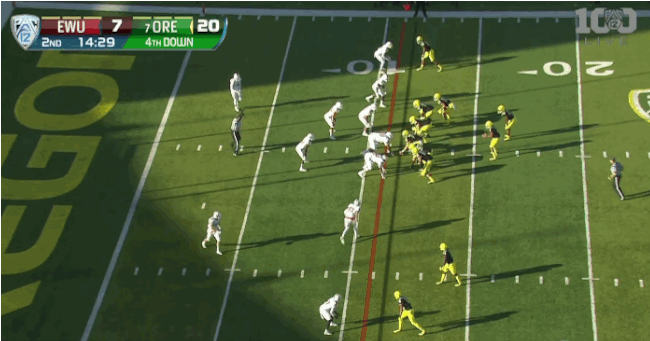
A Power Play intended for between the tackles goes outside!
There are a number of reasons for the success of the Power Play. Obviously the blocking is the biggest component, but the vision and reaction of the running back can make or break the success of the play as well. Cut the wrong direction and a touchdown could be lost. Reading the blocks in the Power Play is very similar to that of the Inside Zone Read, in that it improves the play’s overall success rate.
A key aspect for Oregon is the redundancy inherently built into the Power Play as part of the overall Ducks offense. The steps and the decisions are the same for the RB as the Inside Zone Read. This increases the difficulty for the defense to identify what is coming at them, because both plays look similar, but are blocked differently.
However, the simplicity of the play for the Oregon players, regardless of formation, makes it that much easier to practice and prepare, and allows them to play faster despite throwing multiple looks at a defense.
The Power Play for Oregon may have been revised under coach Mark Helfrich, but it remains one of the foundational plays of the Oregon Offense.
“Oh how I love to learn about our Beloved Ducks!”
Charles Fischer
Oregon Football Analyst for CFF Network/FishDuck.com
Eugene, Oregon
Top Photo by Gary Breedlove

Charles Fischer has been an intense fan of the Ducks, a season ticket holder at Autzen Stadium for 38 years and has written reports on football boards for over 26 years. Known as “FishDuck” on those boards, he is acknowledged for providing intense detail in his scrimmage reports, and in his Xs and Os play analyses. He is single, has a daughter Christine, and resides in Eugene Oregon where he was a Financial Advisor for 36 years.
He now focuses full-time on Charitable Planned Giving Workshops for churches and non-profit organizations in addition to managing his two Oregon Football Websites, of FishDuck.com and the Our Beloved Ducks forum. He is a busy man!
He does not profess to be a coach or analyst, but simply a “hack” that enjoys sharing what he has learned and invites others to correct or add to this body of Oregon Football! See More…

